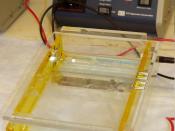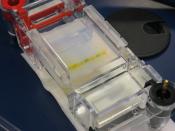TITLE: Distinguishing the Evolutionary Trend Among Mammals
INTRODUCTION:
The process of evolution changes macroevolution within organisms. These changes can be studied using electrophoretic techniques. Using this technique you can find differences among organisms to reflect the length of time that the lines have been distinct and the degree of divergence between those lines. (Helms, 2003). The properties of a specific protein such as lactate dehydrogenase (LDH) in different mammals are seen by using the technique of electrophoriesis. The mammals are herbivourous animals called ungulated and can be divided into two different major orders: the artiodactyls that has even number toes on each foot and perissodactyls that has odd number of toes in each foot.
The lactate dhydrongenase is an enzyme that catalyzes the conversion of pyruvic acid (pyruvate) to lactic acid (lactate). This protein is produce by most tissues and is also found in blood serum. The LDC is controlled by two genes and exists as five isoenzymes; all five isoenzyme catalyze the same reaction but they differ in their amino acid composition and net charge.
(Helms, 2003). Of the five isoenymes, the differences include the molecular weights between the LDH's. The differences are seen in the amount traveled by each LDH compared to each other. Using this we can determine the evolutionary trends among the mammals tested.
In a previous experiment, we studied the enzyme, peroxidase, by using the shoot and the root of a corn seedling and measuring how much it has traveled during electrophoresis. We related this to our experiment that the more closely related the bands after the electrophoresis has run, the more closely related the evolutionary relationships. I believed that the sheep and the goat, since they are artiodactyls, they are going to be more closely related to each other. Our hypothesis then became, the...


![WDM2A 16844 [LDH] NR](https://s.writework.com/uploads/3/34994/wdm2a-16844-ldh-nr-thumb.jpg)